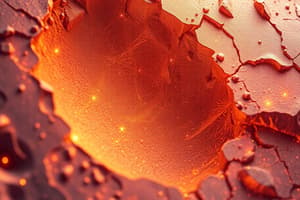Podcast
Questions and Answers
Ductility is the ability of a material to be stretched without breaking.
Ductility is the ability of a material to be stretched without breaking.
True (A)
Ceramics are typically known for their high ductility.
Ceramics are typically known for their high ductility.
False (B)
Thermoplastics can be remolded multiple times upon heating.
Thermoplastics can be remolded multiple times upon heating.
True (A)
Steel is a type of non-ferrous metal.
Steel is a type of non-ferrous metal.
Differential Scanning Calorimetry (DSC) is used for thermal testing of materials.
Differential Scanning Calorimetry (DSC) is used for thermal testing of materials.
Concrete is a type of polymer material.
Concrete is a type of polymer material.
Corrosion is primarily a chemical interaction affecting materials, especially metals.
Corrosion is primarily a chemical interaction affecting materials, especially metals.
Tensile tests are used to measure the electrical conductivity of a material.
Tensile tests are used to measure the electrical conductivity of a material.
Carbon fiber is an example of a fiber-reinforced composite material.
Carbon fiber is an example of a fiber-reinforced composite material.
Fracture mechanics studies the behavior of materials under repeated stress.
Fracture mechanics studies the behavior of materials under repeated stress.
Flashcards are hidden until you start studying
Study Notes
Properties of Materials
- Mechanical Properties:
- Strength (tensile, compressive)
- Hardness
- Ductility and brittleness
- Toughness
- Thermal Properties:
- Thermal conductivity
- Specific heat capacity
- Thermal expansion
- Electrical Properties:
- Conductivity
- Resistivity
- Dielectric strength
- Chemical Properties:
- Corrosion resistance
- Reactivity with other substances
Types of Materials
- Metals:
- Ferrous (e.g., steel, iron)
- Non-ferrous (e.g., aluminum, copper)
- Polymers:
- Thermoplastics (e.g., polyethylene)
- Thermosetting plastics (e.g., epoxy)
- Ceramics:
- Traditional (e.g., porcelain)
- Advanced (e.g., silicon carbide)
- Composites:
- Fiber-reinforced (e.g., carbon fiber)
- Particle-reinforced (e.g., concrete)
Material Testing Methods
- Mechanical Testing:
- Tensile test
- Compression test
- Impact test
- Thermal Testing:
- Differential Scanning Calorimetry (DSC)
- Thermogravimetric Analysis (TGA)
- Electrical Testing:
- Conductivity measurement
- Capacitance testing
- Chemical Testing:
- pH testing
- Spectroscopy methods (e.g., FTIR, UV-Vis)
Applications of Materials
- Construction:
- Steel and concrete used in buildings, bridges
- Automotive:
- Metals for structural components; polymers for interiors
- Aerospace:
- Lightweight composites for aircraft
- Electronics:
- Conductive materials for circuit boards; semiconductors for chips
Material Interactions
- Phase Changes:
- Melting, solidification, phase transitions
- Corrosion:
- Electrochemical processes affecting metals
- Fatigue:
- Repeated stress leading to material failure
- Fracture Mechanics:
- Study of crack propagation in materials
- Adhesion and Bonding:
- Interaction between different materials at interfaces
Properties of Materials
- Mechanical properties define how materials respond to forces: strength, hardness, ductility, brittleness, and toughness are crucial characteristics.
- Thermal properties influence heat transfer: thermal conductivity, specific heat capacity, and thermal expansion determine material behavior with temperature changes.
- Electrical properties assess material performance in electric fields: conductivity, resistivity, and dielectric strength are fundamental for electronic applications.
- Chemical properties refer to material stability and reactivity: corrosion resistance and interaction with other substances are vital for longevity and safety.
Types of Materials
- Metals are categorized into ferrous (containing iron, such as steel) and non-ferrous (like aluminum and copper) based on their composition and properties.
- Polymers exhibit diverse types: thermoplastics (can be melted and remolded) like polyethylene and thermosetting plastics (harden permanently after curing) such as epoxy.
- Ceramics can be traditional (e.g., porcelain, used in pottery) and advanced (e.g., silicon carbide, utilized in high-performance applications).
- Composites combine materials for enhanced properties: fiber-reinforced composites (e.g., carbon fiber, strong and lightweight) and particle-reinforced composites (e.g., concrete, used in construction).
Material Testing Methods
- Mechanical testing evaluates strength and durability through various methods: tensile tests measure elongation, compression tests assess resistance to being squished, and impact tests determine toughness.
- Thermal testing involves techniques like Differential Scanning Calorimetry (DSC) for heat flow measurement and Thermogravimetric Analysis (TGA) for weight changes with temperature.
- Electrical testing includes measuring conductivity to assess how well a material conducts electricity and capacitance testing to evaluate energy storage in electrical fields.
- Chemical testing involves techniques such as pH testing to measure acidity and various spectroscopy methods (e.g., FTIR, UV-Vis) to analyze material composition.
Applications of Materials
- In construction, steel and concrete are primary materials for building structures such as buildings and bridges due to their strength and durability.
- The automotive industry utilizes metals for structural components and polymers in interiors for weight reduction and cost efficiency.
- Aerospace applications often involve lightweight composites, essential for improving fuel efficiency and performance in aircraft.
- In electronics, conductive materials are crucial for circuit boards, and semiconductors play a significant role in computer chips.
Material Interactions
- Phase changes, such as melting and solidification, affect material properties during heating and cooling processes.
- Corrosion involves electrochemical processes, significantly impacting the longevity of metals in various environments.
- Fatigue refers to material degradation caused by repeated stress, leading to eventual failure under cyclic loading.
- Fracture mechanics studies crack propagation and the conditions leading to failure in various materials.
- Adhesion and bonding are critical in multi-material systems, affecting how well materials interact at their interfaces.
Studying That Suits You
Use AI to generate personalized quizzes and flashcards to suit your learning preferences.




